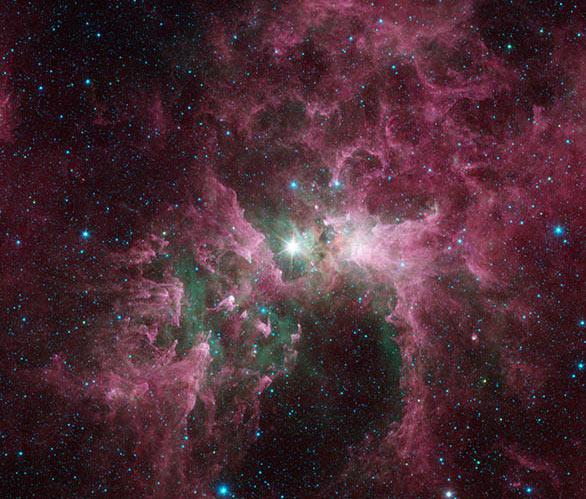Ten years ago today, on Aug. 25, 2003, NASA launched the Spitzer Space Telescope aboard a Delta II rocket into space.
Happy tenth anniversary, Spitzer!
It’s been a wildly successful decade. The telescope’s mirror is relatively small as these things go; it’s a mere 85 centimeters (34”) across—compare that to Hubble, which has a 2.4 meter mirror. But you don’t need a huge piece glass (or in this case, beryllium) to make a big impact: Spitzer was the most sensitive and highest-resolution telescope ever launched that could see in the infrared. This is the domain where “cooler” objects shine, objects like planets heated by their stars, where kinda-sorta stars called brown dwarfs are bright, where long molecular chains of carbon—what astronomers call dust—glow eerily.
Dust is opaque in visible light, so when Spitzer turns its eye to these dust clouds, it sees intense beauty. The image at the top of this post is of the massive and luminous blue star Zeta Oph, which is ramming the dust around it and creating that incredible bow wave in space. Compare that to the IR image taken by WISE that I posted just the other day.
In May 2009, Spitzer ran out of the coolant needed to use its far infrared detectors. But it still had two (out of an initial four) detectors that weren’t severely affected by this, so operations continued. This “warm phase” has been going strong for over four years now, with Spitzer still cranking out amazing observations of the Universe.
And the data it collected is still in the archives, available to astronomers around the world. For example, the folks at Spitzer just released another gorgeous image composed of earlier observations from the archive:

Photo by NASA/JPL-Caltech
That’s the dust and gas in the Carina Nebula, a vast star-forming complex over 7000 thousand light years from Earth. The bright star in the middle, Eta Carinae, is blasting out radiation that is so intense it’s carving out and blowing away the material around it; you can see long structures like fingers pointing at Eta Car. Those are dense filaments of material left over as the lighter stuff gets destroyed; think of them like sandbars slowly eroding in a swift current.
Spitzer is one of four sister telescopes in NASA’s Great Observatories line (the others are Chandra, Hubble, and Compton), each designed to see unprecedented detail in a different wavelength of light. Whenever we build machines like this we learn a vast amount, and Spitzer has contributed more than its fair share. I urge you to visit the Spitzer website and peruse some of the more photogenic of its observations, or read some of the many, many articles I’ve written about it over the past decade, and learn more about this magnificent eye on the cool cosmos.
